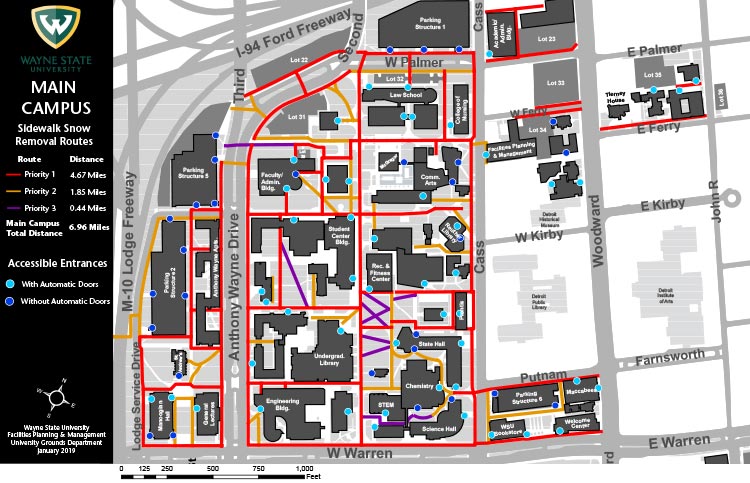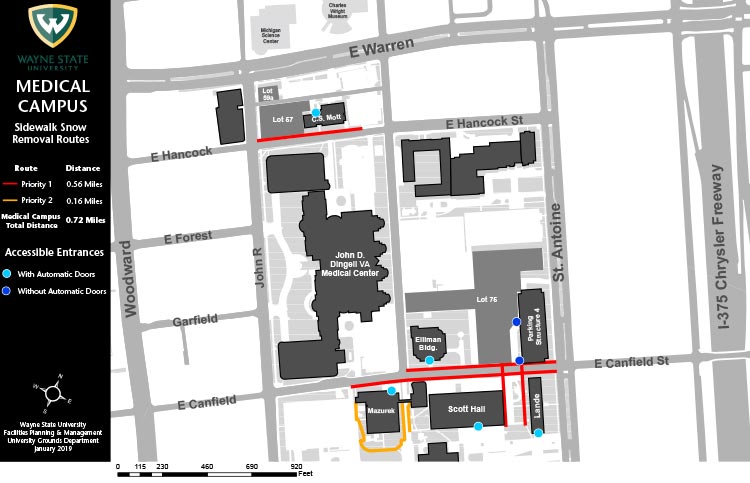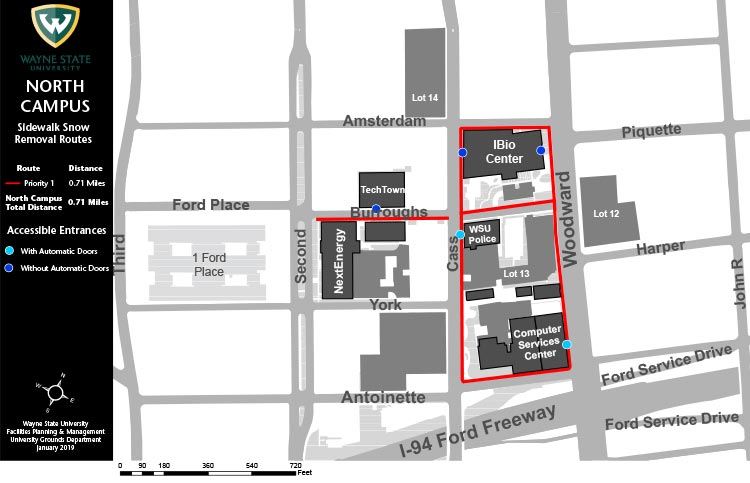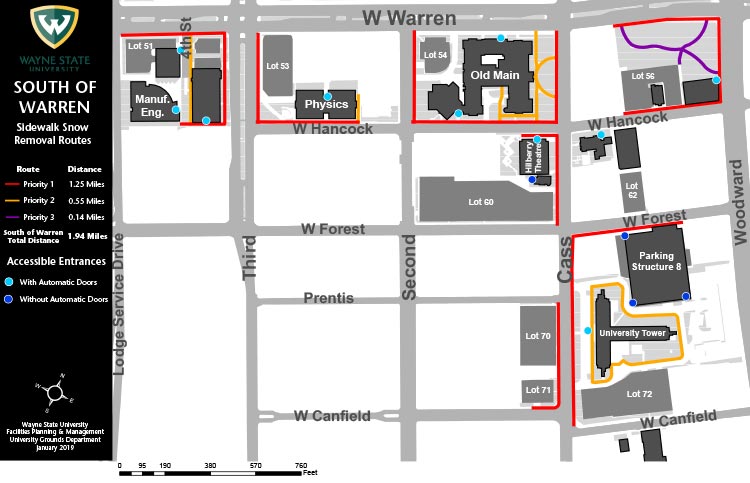Introduction
As part of FP&M's Facilities Forward initiative, the purpose of this snow plan is to standardize Wayne State University's snow removal protocol and procedures. During the winter months, Grounds Services will closely monitor the weather forecast from various providers to remain proactive for upcoming storms. This snow policy is subject to change at any given time without notification.
Goal
The goal of FP&M's snow and ice removal operation is to maintain adequate traction for pedestrians and vehicles during winter storm conditions. The implementation of the removal procedures does not mean that bare pavement should be expected during or immediately after each event.
Overview
FP&M will routinely review the results of this plan and make revisions to improve the effectiveness of the snow and ice control efforts.
Operational snow and ice removal schedules will be based off many variables which include projected weather conditions, duration of the storm, time of day, and the time of year. While snow removal crews will work steadily to keep the snow/ice clear during severe weather conditions, it is unlikely that campus crews will maintain all sidewalks and entryways in real-time. Individuals must be prepared to commute to and from campus buildings safely.
Students, faculty, and staff are encouraged to plan their paths of travel. Alternate routes may require travel that they might not generally use. If conditions make for unsafe travel, please try to remain in a safe place and make alternate arrangements until the snow or ice is reasonably clear.
Safety & Training
The safety of the campus community is the utmost importance. Training of all employees involved in snow and ice removal operations will occur before every winter season. Equipment utilized will include pickup trucks and utility vehicles equipped with plows, salters, liquid deicers, loaders, tractors, snow blowers, and shovels.
Areas of responsibilities
Grounds services are responsible for clearing snow and ice from University sidewalks, stairways, building entryways, and emergency egresses. Areas also include loading docks and University walkways to/from parking lots and structures.
Event procedures by snowfall amounts
Trace amounts to 1" of snowfall accumulations: Crews will apply pre and post treatments of salt and liquid deicer only as conditions require (minimum application rate).
1" to 2" of snowfall accumulations: Crews will power sweep, plow, and shovel as necessary. Crews will apply pre and post treatments of salt and liquid deicer to walkways, building entryways, steps, and ramps.
2" to 6+" of snowfall accumulations: Crews will power sweep, plow, and shovel to keep lots and sidewalks open. It is important to conserve as much salt as possible to ensure we have adequate stock for following storms. Therefore, during heavy periods of snowfall, bulk salt and deicers may not be applied until the snow has slowed or ceased. Refer to priority path mapping for an understanding of operational sequence for removal activities.
Forecasted & unforecasted events
Weekdays during business hours: If a storm develops during business hours, crews will work the event throughout the day and into the evening hours.
If a forecasted storm develops during the week between non-business hours, crews will be scheduled in advance. Generally, crews will begin snow removal operations by 3:00 am.
If an unforecasted event develops during nonbusiness hours, WSU Public Safety will notify the Grounds department after 1" of accumulations. Crews will be called in immediately and deployed upon arrival.
Grounds crews will work reduced hours during weekends, holidays, and campus closures. Snow removal plans and priorities will be modified during these periods. Thus, sidewalks and entryways may not be cleared until a later time.
Priorities
Priority I is defined as opened as soon as possible and re-checked periodically during the event. Areas will generally be cleared within 3-4 hours of a snow event, or actively during the event. Priority I areas include handicap ramps, handicap entrances/exits, stairways & steps, major mall walkways, high traffic building entrances, high traffic perimeter walks, main routes from parking lots and structures.
Priority II is defined as opened upon completion of Priority I. Areas may remain unclear and untreated due to additional precipitation or refreezing. Areas will generally be cleared within 4-8 hours of a snow event. Priority II areas include moderate traffic building entryways, secondary/adjacent walkways, and emergency egresses.
Priority III is defined as opened if possible, but only after Priority I & Priority II are opened and maintained. Priority III may remain untreated due to changing conditions, or may not be opened until the conclusion of the event. Areas will generally be cleared within 24 hours of the end of the event. Priority III areas include low traffic building entryways and perimeter walkways.
When does salt work, when does it not?
As no two storms are alike, salt is most effective at temperatures above 20 degrees F. As the temperature drops, the salt's effectiveness drops dramatically. Around 10 degrees F and below, salt hardly works at all. Salt is also ineffective against freezing rain, or rain that changes over to freezing rain because it gets washed away. Please remember to use extreme caution when traveling during these periods.
What can you do?
Always remember to do your part by using extreme caution in adverse weather conditions and dress accordingly to the weather forecast to ensure safe travels. University grounds personnel will do its best to provide safe paths of travel, and we ask that faculty, staff, and students to take personal responsibility for their safety by using cleared routes.
Work with our snow-removal experts to ensure safety. Snow-removal equipment is large, loud and difficult to stop. Pedestrians and vehicles should allow a wide safety area around plows and equipment during operations. While equipment operators are on the lookout, their main focus is on the task of removing snow for public safety.
Avoid darting out in front of or behind such equipment, and make eye contact with a snow-removal driver before crossing in front of them.
Walking or driving too closely in front or behind equipment can create unsafe conditions. Stay back & stay safe!
On sidewalks: Avoid parking so close to the sidewalk that the car's bumper hangs over the walk. It creates an obstacle for snow removal equipment.
Can you help keep the campus safe? Containers of ice-melt are located at entrances to most campus buildings. If no salt is visibly present, please feel free to spread some of the ice-melt around to cover the area.
Fun facts
Did you know that our Grounds department:
Applies over 450 ton of salt every winter
Plows and salts over 15 miles of sidewalks per event
Clears and salts over 350 building entryways
Athletic campus map

Main campus map

Medical campus map

North campus map

South campus map

South of Warren map

View snow and ice removal manual PDF








